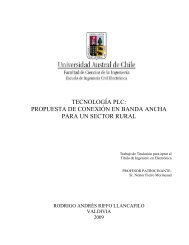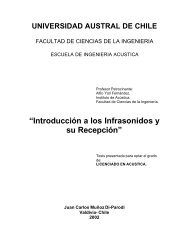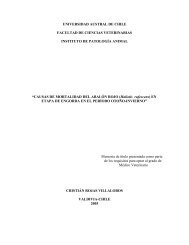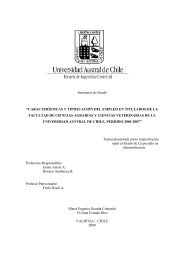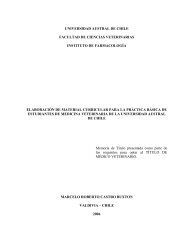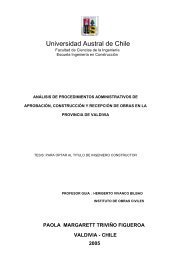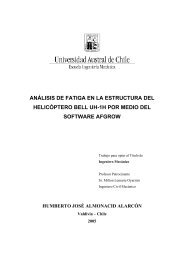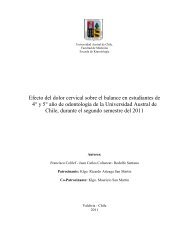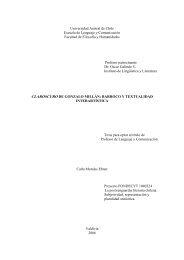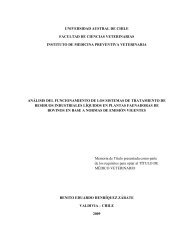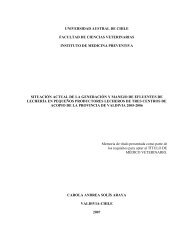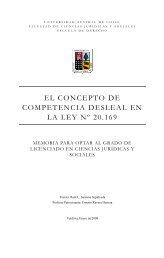Diversidad y control biológico de insectos - CyberTesis UACh ...
Diversidad y control biológico de insectos - CyberTesis UACh ...
Diversidad y control biológico de insectos - CyberTesis UACh ...
You also want an ePaper? Increase the reach of your titles
YUMPU automatically turns print PDFs into web optimized ePapers that Google loves.
predators extracted from soil cores followed the same pattern that predator activity <strong>de</strong>nsity<br />
from pitfall trapping. The soil cores estimation was performed 30 days after spraying, thus<br />
it comprised the first two sampling dates of pitfall trapping estimates.<br />
The predator guild was numerically dominated by carabid beetles (68%) and spi<strong>de</strong>rs (26%).<br />
Much research efforts have been focused in these two groups because a) most of the species<br />
are polyphagous predators and thus the taxonomic groups as a whole are consi<strong>de</strong>red<br />
beneficial (Duelli et al., 1999); and b) they have properties for biodiagnostic purposes and<br />
thus have an bioindicative value (Marc et al., 1999).<br />
Negative effects of lambda-cyhalothrin on ground-dwelling predators, especially carabids<br />
and lycosid spi<strong>de</strong>rs, have been wi<strong>de</strong>ly reported on literature (Wehling and Heimbach, 1991;<br />
Brown et al., 1990; Krause et al., 1993; Hof et al., 1995). Some authors have characterized<br />
the effects as weak or transient (Candolfi et al., 2004; White et al., 1990; Wick and Freier,<br />
2000; Berg et al., 1998), while others reported that the effects were strong or persistent<br />
(Dinter and Poehling, 1992; Dinter and Poehling, 1995; Rose, 2005). Some groups<br />
increased after lambda-cyhalothrin application (Wick and Freier, 2000).<br />
On the other hand, some B. bassiana strains have caused mortality on non-target predator at<br />
the laboratory level, but in general field effects of this fungus are negligible or non existent<br />
(Rie<strong>de</strong>l and Steenberg, 1998; Wang et al., 2001, but see James et al., 1995; Jaronski et al.,<br />
1998; Flexner et al., 1986), even when a dose as high as 10 14 spores per ha was applied in<br />
forests (Parker et al., 1997). Limited epizootic of B. bassiana on staphylinids were reported<br />
by Steenberg et al., 1995.<br />
In our study, lambda-cyhalothrin <strong>de</strong>creased the predator guild by 49-74%, <strong>de</strong>pending on the<br />
collecting method (weighted mean = 54%). This effect was almost constant throughout the<br />
experiment, as the magnitu<strong>de</strong> of the <strong>de</strong>crease was similar in each sampling date. No<br />
recovery was observed at the last sampling date.<br />
Insectici<strong>de</strong> application reduced predator activity-<strong>de</strong>nsity immediately beginning from 1 day<br />
after treatment. This instantaneous effect could be attributed to direct toxicological<br />
properties of lambda-cyhalothrin on predators, but the persistent <strong>de</strong>crease (at least 60 days)<br />
could be the result of more complex ecological mechanisms. Acute toxicity of lambda-<br />
cyhalothrin could not persist for 60 days in the pasture, especially if high temperatures and<br />
organic matter are present. Therefore, mechanisms such as loss of habitat quality, lack of<br />
84



